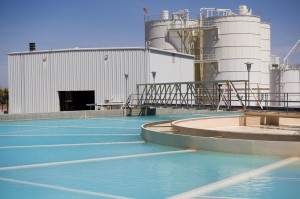- Slug: Desalination-Committee,530
- Sidebar: Yuma Desalting Complex.
- Photos available (thumbnails, captions below)
By BECKY BRISLEY
Cronkite News
PHOENIX – Saying it’s important to prepare for any contingencies, a state lawmaker wants to create a committee to study the feasibility of using desalinated water to augment Arizona’s water supply.
Rep. Steve Montenegro, R-Avondale, authored legislation to have lawmakers and experts review the history of desalination in Arizona, study data from a Yuma plant built to desalinate agricultural runoff and look for opportunities to use desalination in the future.
“I think that this bill is going to allow us to continue that conversation as to what we need to do to be better stewards and also to better obtain water,” said Montenegro, the House majority leader. “Water is very important to the state of Arizona. It’s important to our constituents in Yuma. It’s important to rural Arizona, to agriculture, and it’s important to the entire state as a whole.”
HB 2445 won a unanimous endorsement Feb. 5 from the House Agriculture, Water and Lands Committee.
“We as the State of Arizona need to look at new sources of water, renewable sources of water,” said Rep. Rosanna Gabaldón, D-Sahuarita, one of those voting for the bill. “I believe that this study can not only look at desalination but also how to address brackish water. Every drop of water is very important, and we don’t know the value of our water until our well runs dry.”
The committee would be comprised of: two members from the House and two from the Senate, representing each political party; one member who has experience with the Yuma desalting plant; one member who has experience with other desalination projects; and one faculty members each from the major state universities with expertise in hydrology, desalination or another relevant field.
It would have until the end of 2015 to report findings and recommendations to the governor, House speaker and Senate president.
Sarah Porter, director of the Kyl Center for Water Policy at Arizona State University’s Morrison Institute for Public Policy, said that while the center doesn’t have a definitive stance on desalination it is one strategy for augmenting the state’s water supply.
“In addition to these strategies, there are also strategies to reduce demand,” Porter said. “For example, by improving the efficiency of water delivery and use technologies.”
Porter said all of these strategies entails costs, benefits and disadvantages, as well as thoughtful analysis. She said that the Arizona Department of Water Resources has warned that without planning and action in the next 25 to 50 years Arizona could face a significant gap in supply.
“The process of developing new water projects and management techniques is complicated and takes a long time,” she said. “So to address that potential shortfall Arizona needs to start planning now.”
Phil Gordon, former mayor of Phoenix, has been an advocate of the desalination since he visited the Middle East and saw how it has altered the landscape and economy of countries like Dubai. He has proposed negotiating with Mexico to create desalination plants on the Sea of Cortez that would benefit both countries.
“We could turn a barren desert into farmland,” Gordon said. “Water, being such a precious and critical component to growth and survival, is something we need to make sure we have sufficient amounts of.”
^___=
Yuma Desalting Plant:
Part of a lawmaker’s proposal to create a study committee on desalination is examining data from the Yuma Desalting Plant. Some facts about the U.S. Bureau of Reclamation facility:
• Purpose: Created to treat agriculture runoff from the Wellton-Mohawk Irrigation and Drainage District.
• Goal: Delivering treated water to Mexico under an agreement on Colorado River would support Lake Mead’s supply.
• Construction: Completed in 1992 at a cost of $250 million.
• Operation: With sufficient supply in the Colorado River to meet obligations to Mexico, the plant has only operated for two test runs, in 2009 and 2012.
^___=

The Yuma Desalting Plant opened in 1992 to treat agriculture runoff under an agreement with Mexico on rights to Colorado River water. While it has been tested, there has yet to be a need to run the plant. (U.S. Bureau of Reclamation Photo)

Rep. Steve Montenegro, R-Avondale, authored legislation to create a committee studying the history and future feasibility of desalination in Arizona. (Cronkite News Photo by Hunter Marrow)